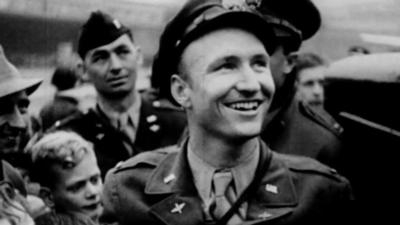Col. Gail Halvorsen Was Also Known As 'Uncle Wiggly Wings'
The Berlin Candy Bomber, Col. Gail Halvorsen, will be among members of the Civil Air Patrol receiving a Congressional Gold Medal for their service during World War II. The Congressional Gold Medal is the highest award Congress can give to a civilian.

The Congressional Gold Medal ceremony will take place at 3 p.m. in Statuary Hall at the Capitol. About 40 living veterans and dozens of members of their families, as well as the families of deceased veterans, will be in attendance. Later that evening, a celebratory dinner sponsored by CITGO will be held at 7 p.m. at the Hyatt Regency Crystal City Hotel in Arlington, VA, where bronze replica medals will be presented to the World War II-era CAP members courtesy of the oil giant. Sunoco and Sunoco Logistic are also major sponsors of the events.
PBS will be airing a documentary on Col. Halvorsen's story. Gail "Hal" Halvorsen was a C-54 pilot who became known worldwide as the "Candy Bomber" during the Berlin Airlift in 1948. This is the touching story of one man's efforts to bring a little joy to the children of a defeated enemy with two sticks of gum and candy tied to handkerchief parachutes. Halvorsen's simple act of kindness was the beginning of a mission that brought hope to the children of a blockaded West Berlin.
In June 1948, Russia laid siege to Berlin, cutting off the flow of food and supplies over highways into the city. More than two million people faced economic collapse and starvation. The Americans, English and French began a massive airlift to bring sustenance to the city and to thwart the Russian siege.
Gail Halvorsen was one of hundreds of U.S. pilots involved in the airlift. While in Berlin, he met a group of children standing by the airport watching the incoming planes. Though they hadn't asked for candy, he was impressed to share with them the two sticks of gum he had in his possession. Seeing how thrilled they were by this gesture, he promised to drop more candy to them the next time he flew to the area.

True to his word, as he flew in the next day, he wiggled the wings of his plane to identify himself and then dropped several small bundles of candy using parachutes crafted from handkerchiefs to slow their fall. Local newspapers picked up the story. Suddenly, letters addressed to "Uncle Wiggly Wings" began to arrive as the children requested candy drops in other areas of the city.
Enthusiasm spread to America, and candy contributions came from all across the country. Within weeks candy manufacturers began donating candy by the boxcar.
In May 1949, the highway blockade ended, and the airlift ended in September. But the story of Uncle Wiggly Wings and the candy-filled parachutes lives on -- a symbol of human charity.
Gail Halvorsen was born in Salt Lake City, Utah, and grew up on small farms in Utah and Idaho. He earned a private pilot license under the non-college Civilian Pilot Training program in Sept. 1941. Almost concurrently Halvorsen joined the Civil Air Patrol as a pilot. He joined the United States Army Air Corps in June 1942. Fighter pilot training was with the Royal Air Force after which he was returned to the Army Air Corps and was assigned flight duty in foreign transport operations in the South Atlantic Theater.
After WWII he flew in the Berlin Airlift, where he became known as "Uncle Wiggly Wings," the "Chocolate Flyer" and the "Berlin Candy Bomber." The blockade of Berlin began in June 1948 and ended May 12, 1949. Flights continued until Sept. 30, 1949, to build up reserves.
(Images provided with news release)
 ANN's Daily Aero-Term (05.10.24): Takeoff Roll
ANN's Daily Aero-Term (05.10.24): Takeoff Roll Aero-News: Quote of the Day (05.10.24)
Aero-News: Quote of the Day (05.10.24) Aero-News: Quote of the Day (05.11.24)
Aero-News: Quote of the Day (05.11.24) ANN's Daily Aero-Term (05.11.24): IDENT Feature
ANN's Daily Aero-Term (05.11.24): IDENT Feature ANN's Daily Aero-Linx (05.11.24)
ANN's Daily Aero-Linx (05.11.24)




